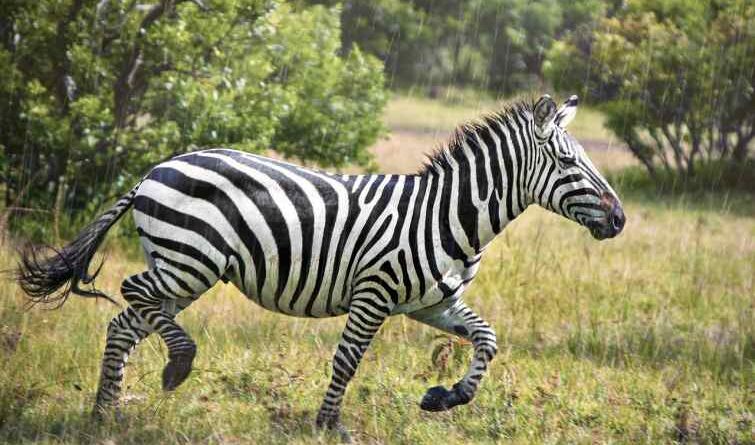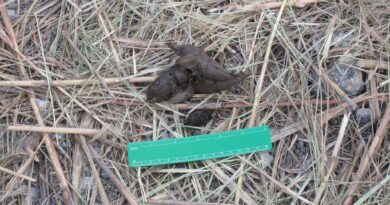ZEBRA
The zebra is Africa’s version of the wild horse. It looks very different from the horses we know and care for, but underneath its beautiful skin, it is pretty much the same kind of animal as the horses we see in the stable yard or at the racetrack. The only difficult difference between it and a domestic horse is that it has a striped coat and is much harder to train. The horse is a kind and helpful animal that is easy to turn into “man’s best slave.” The zebra is much less friendly, and it has never let a person ride on its back. When a film about a “jungle princess” was being made in Africa, this was a problem because in the story, she was supposed to travel around on the back of her tamed zebra. The film was scrapped because no such animal could be found.
The business had to hire a girl who had a white horse and convince her to carefully paint black stripes on it. Zebras have never been tamed, so the only place you can see a lot of them now is on the grassy plains of tropical Africa, where they came from. There, they live in small groups, each with a strong male, his harem of females, and their young. The male has to spend a lot of energy keeping his small group together and making sure they don’t wander off. The other, less successful men stand back and watch with respect.
These group together with other males and wait for the day when they might be strong enough to win a harem of females. One of these young stallions will sometimes take a chance and challenge an older male to a fight. If he wins, he’ll be able to drive the older one away and take over his harem.
A stallion can also become a harem-master by waiting until the younger females are old enough to want to go on their own. When they are about to become adults, this happens. Both young males and young females leave their family group and drift away instead of staying with their parents. The nearby bachelor stallions watch these movements closely and move quickly to get as many young females under their control as they can. In this way, new groups are made, and soon they will start to breed. Like horses, zebras almost always only have one birth at a time. Twins are almost never born. When the mare is ready to have a birth, she goes to the quietest spot she can find.
Whether she is or not if she is worried or upset, she puts off giving birth. She can keep doing this for a few days if she needs to, until she thinks the time is right. Then she will let her baby foal go out into the harsh world. If she wasn’t able to give birth at this time, her baby would be much more likely to be killed by killers who were waiting nearby. When it shows up, the foal zebra has no time to waste. Since there are always hungry killers around, it can’t lie on the ground for too long. Within 10 minutes, it can stand on its own and eat from its mother. It looks like its skinny legs are getting stronger by the second. It is ready to start trotting with the herd only half an hour after it is born.
When the group is resting, the mother will lick her new baby many times. This is how she will learn the smell of each of her babies. At the same time, the foal will learn to recognise its mother’s smell. In no time, they will be able to identify each other and have grown a strong love for each other.
As time goes on, the young zebra will be able to tell each member of its herd apart not only by their smell but also by the way their black and white stripes are arranged. Just like fingerprints, every zebra has its own unique pattern, and no two are the same. The foal’s biggest problem as it gets older will be keeping up with the group. Its mother will feed and protect it as best she can, but if the group has to flee away from lions or packs of wild dogs, the newcomer may not be able to keep up. If the group breaks up because of panic, the foal may be left alone. If that happens, it will be in a very dangerous situation. A lot of zebras are killed before they reach adulthood.
When the hunters are gone and the herd has spread out, the zebras start calling to each other in their own way. Each animal has its own call and knows its own voice, so they can quickly get back together as a family group. This means that zebras can tell each other apart by their body odour, their ways, and their voice. When they are close together or at night, smell can be used. When the spaces between the stripes are not too big, they can be used. Voice and writing can be used when people are far away from each other. Having these three ways to stay in touch is very helpful for an animal that needs to always live with its family group to stay alive.
Zebras can be brave at times. They don’t always flee away when they are attacked by killers. If the mare sees her foal being attacked, she may become very angry and fearless all of a sudden, and her stallion may also start acting mean. Lions with more hunting experience know this could happen and take steps to protect themselves, but young lions on their first hunts aren’t always ready for the anger of the zebras. The wild kicking of the angry herd can sometimes hurt the big cats very badly. People say that zebras even attacked a man at one point. The family of a zebra foal that was killed by a poacher was so angry that they kicked and bit him to death.
Within a year, the young zebra will be able to take care of itself and will no longer need to be fed by its mother. If it is a female, it will stay with its family for about another year before drifting away. Young boys tend to stay with their original families for a little longer. They often wait until they are four years old before leaving to join the nearby bachelor groups.
When these young males are about seven years old, they will start to challenge the older stallions and try to get them to leave their harems. If the males are getting old around the age of 18, they may no longer be strong enough to win the fight and may have to leave to live a sad, lonely old age. If they are still in their prime, though, they will quickly send the younger men away. The weather changes how the herd spends each day. When it rains, they don’t move around much and tend to stay in their sleeping area. If the weather is good, they leave at dawn in single file, leaving the place where they slept behind.
They eat, drink, and rest after that. For the rest of the day, they eat, drink, and sleep. In the late afternoon, they walk back to their favourite sleeping spot, where they spend the hours of darkness. During the night, they have three main sleep times that are separated by short “grazing snacks.”
All of this changes if there is a drought and the water holes dry up. Zebras can’t go very long without drinking, while camels can. If they can’t find water in three days, they are in big trouble. So, when the dry season comes, the small groups of families join together to make a huge family of hundreds of animals, and they all travel to a place where it rains more. This may mean that they have to travel a long way, but they are strong animals that can keep going for hours without getting tired. When the zebra is keeping a rest, it spends a lot of time cleaning itself. It does this in many different ways. It may lick or nibble its skin.
It can scare flies away by moving its skin or by swishing them away with its long tail. It can also drive them away by stomping hard on the ground with one foot. Like a dog, it can scratch itself with its back leg. If it has a sore spot, it can rub against a tree trunk or branch to get rid of it. If its back is itchy, it can throw itself on the ground and roll over on the dirt or on a patch of sandy soil. If one zebra is resting near another, the two animals will often stand head to tail. Then, they can swish the flies off each other’s faces. Or, they may stand head-to-head and bite each other’s necks and manes where they can’t reach themselves.
Why zebras have such bright black and white coats is the biggest mystery about them. People used to think that the zebras’ stripes helped them hide from their enemies, but this is not true. If you go to Africa, it doesn’t take long to see how easy it is to spot a group of zebras. Their stripes really don’t do anything to hide them. There must be another reason why stripes are there, but no one can agree what it is.
Some people think that the black and white spots confuse the lions when they attack, making them miss their prey as they pounce. Others think that when zebras run away together in a herd, it’s difficult to tell where one animal ends and another begins because of their stripes. Because of this, it is thought that a lion attacking a group of people would have a difficult rest picking out a single victim.
Another idea is that the stripes help the animals who wear them tell one kind of zebra from another. There are three main types of zebras still alive today: the common plains zebra, which lives on the grasslands of most of East Africa, the rare Grevy’s zebra, which lives further north, and the very rare mountain zebra, which lives in the south. Could it be that the different patterns of stripes tell the animals where their own “troops” are, like flags on a battlefield? This doesn’t seem very likely because the stripes look pretty much the same from a distance.
To see the differences, you have to get close, but once you do, you can tell each animal apart. Zebras only have something that could be called “flags” on one part of their bodies, which is their rumps. The stripes are very different in this part of the coat. The common zebra has thick lines, the Grevy’s zebra has a strange white patch with a black mark in the middle, and the mountain zebra has thin lines that look like a grid. It’s not a coincidence that this is the part of the zebra that stands out most when it runs away. This makes it easier for a running zebra to stay with its own kind and keeps it from running away in a panic with the wrong herd.
A completely different idea about the stripes is that they are there to keep stinging insects from landing on the animal’s skin and biting it.
It is thought that some insects don’t like landing on such a bright black-and-white pattern and instead go find another victim to bother. If this is true, it would explain why zebras in tropical Africa are healthy and do well. When people took their own horses there, they often got sick with diseases that the zebras don’t seem to get. Maybe it is the stripes that keep them safe.
There are a few other ideas about why zebras have stripes, but no one knows for true which one is the right one. It’s a puzzle that some young zoologist will have to solve in the years to come.



